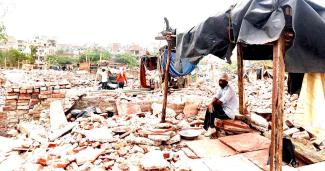September 8-10 were no normal days in the national capital of India. A significant section of the city, especially in the New Delhi area, was divided into controlled and regulated zones. Traffic was restricted, offices closed, security personnel deputed on duty on the streets. The city breathed cautiously for three days. The context was the G 20 summit in India.
G 20 or the Group of 20 is an intergovernmental forum comprising 19 sovereign countries along with the European Union and the African Union. This platform is meant for intergovernmental dialogue for economic co-operation, action against climate change and sustainable development. Among G 20 nations, India has the lowest per capita income, largest percentage of people living under poverty and lowest score in Human Development Index . Delhi, which primarily held the G 20 summit has 49% of its population living in slums and unauthorised colonies without any civic amenities .
Set in this real context, the BJP led central government did all to project the picture otherwise, to the world as well as to the people of the country. More than 4100 crores of rupees were spent alone in Delhi for G 20 makeover of the city. Major portion of the expenditure was for security and beautification. This amount is manifold more than what other countries like Indonesia, Japan, Germany and Argentina had spent in previous years for hosting G 20. Rs 2,700 crores were spent to revamp the G 20 summit venue at Pragati Maidan and build the extravagant Bharat Mandapam to showcase PM Modi’s claimed status of global leader.
In the run up to the final G 20 summit in Delhi, a massive propaganda exercise went on for the last one year throughout the country. Crores of rupees from public exchequer have been spent on advertisements and hoardings with mega size portraits of the PM. An event of international diplomatic negotiations was turned into a domestic affair of propaganda. The scale of the propaganda around G 20 made it amply clear that the party in power is rehearsing its election campaign projecting its frontal face Narendra Modi using public money. The propaganda exercise was named ‘People’s G 20’ by the PM of the country.
Demolished Slums, Displaced Livelihood, Humiliated Poor
Behind the curtain of the propaganda exercise paraphrased as people’s G20 was the story of massive displacement of slums and livelihoods throughout the country. More than 200 meetings of G 20 took place in around 60 cities of the country. Each of these cities faced massive anti-poor drive onwards to these meetings.
Report of the Public Hearing on The Forced Evictions Across India and G 20 Events[1] (The Report henceforth) documents the plight of the poor across India in the backdrop of G 20 events. It documents how from Nagpur, Mumbai, Indore, Vishakhapattanam to Udham Singh Nagar, slums were demolished, vendors evicted from roads and the slums that could not be demolished were hidden behind massive veils. For establishing the pride of Narendra Modi, the poor across cities were forcibly removed from the gaze of the foreign guests. If in Indore all shops along the route of Brilliant Convention were demolished, in Darjeeling the small shop owners and hawkers from the vibrant shopping place of Mall Road were uprooted and not allowed to come back even after the tourism meeting of G 20 was over. Adivasi Bastis were hidden using massive green sheets in cities like Indore and Vishakhapttanam.
Delhi, which was the ultimate destination of the G 20 summit experienced the severest form of anti-poor drive spanning over a period of nearly a year. Flouting all norms of Delhi Urban Slum Improvement Board (DUSIB) or Sudama Singh Judgement of Delhi High Court of 2010 that necessitate proper survey, 30 days notice period and in-situ rehabilitation before any demolition, thousands of houses no shanties were demolished in different parts of the city. The biggest demolition being in the Tughlakabad area where houses close to the Tughlakabad fort were brutally demolished by bulldozers. Residents who have stayed in the area for decades were asked to vacate their houses in January. In April-May, bulldozers started to rampage the area. According to reports more than 46,000 people have been rendered homeless due to the demolition. An on-site visit of the area makes it clear that the number of people actually impacted by the demolition are much more than 46,000. Interestingly, the palace-like residence of BJP MP Ramesh Bidhuri remained untouched in this entire episode. People of Tughlakabad area continued to stay under open sky for months without any rehabilitation package provided by the government. Hundreds of houses, including middle class housing colonies, near Mehrauli Archeological Park were served notice in December, 2022 just after India assumed the presidency of G 20. Finally slums near the area were evicted in February. Poor slum dwellers in Tughlakabad and Mehrauli faced the brunt of bulldozers because foreign delegates were scheduled for heritage walk near Tughlakabad Fort and Mehrauli Archeological Park. In a drive to make them invisible, the lives and livelihood of the working class were brutally decimated by the bulldozer governance of Narendra Modi.
Yamuna Flood Plains was another area that witnessed massive demolition by central government agencies like the DDA. Hundreds of families were evicted from Gyaspur near Nizamuddin between June-August in 2022. More than 3000 people were evicted in Moolchand Basti near the Yamuna flood plain in March, 2023. If archeological sites such as Tughlakabad and Mehrauli were to be cleared off the poor for the purpose of serene heritage walk, Yamuna floodplain was to be ‘cleaned’ for making Bio-Diversity Parks and recreational places.
The anti-poor drive preceding G 20 not only targeted slums, even shelter homes, meant for temporary shelter for homeless people, built by the government were destroyed at several places. The Report indicates that in March eight Shelter Homes were demolished by DUSIB itself. These shelter homes were destroyed so that G 20 dignitaries don’t notice in what condition the government forces the urban poor to stay in its shelter homes. In Sarai Kale Khan, for example, the shelter home was demolished because a park was to be constructed near it for visit by G 20 delegates.
In complete violation of street Vendors Act 2014, Delhi roads were cleared of street vendors forcibly by the police. Even after the completion of G 20, the street vendors have not been allowed to restart their livelihood and are forced to roam around the city fearing police action like criminals.
People vs Power
The cruel reality of ‘People’s G 20’ has been born by the people of Indian cities. All established laws to protect slum dwellers from displacement, to ensure their rehabilitation, to protect street vendors have been flouted by government agencies. The poor has been slapped on the face by massive curtains hung outside their slums to make them invisible. The laws ensuring residential and livelihood rights of the poor have been achieved after years of struggle by the working class and trade unions. The battle to ensure proper rehabilitation and compensation for the poor displaced during G 20 must go on. The humiliation done to the poor must be paid back in equal terms in the upcoming Loksabha election.
Note:
https://wgonifis.files.wordpress.com/2023/07/g-20-public-hearing-6.pdf









